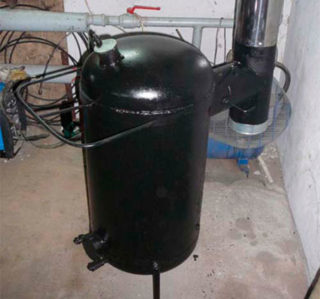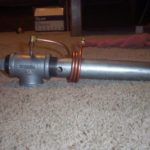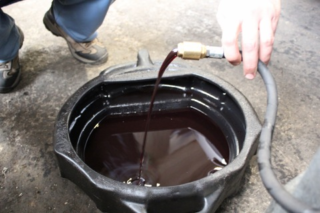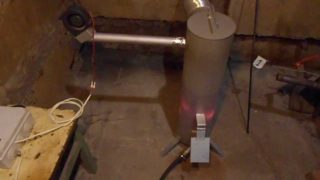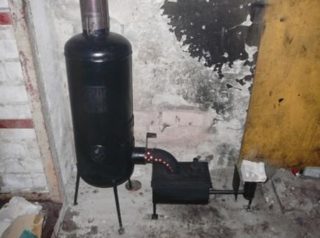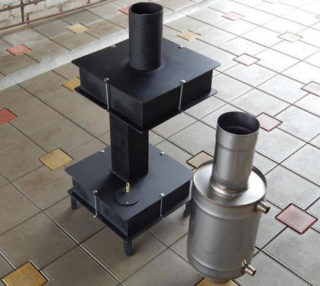Refining refers to already used motor, industrial or transmission oil and fuel oil, which accumulate in large volumes at automobile enterprises, in service stations and in departmental garages. They find application as a cheap and reasonably efficient fuel. This technique allows you to save considerable money, in addition, the heat transfer from working out by power corresponds to the action of an electric heater of 15 kW. The fuel consumption in this case is approximately 0.5-2 liters per hour.
Varieties and arrangement of the furnace
A classic mining furnace designed for use in a garage or workshop can be made in several ways. Three types of structures are known in which this option for producing thermal energy is applied:
- Direct burning device. Oil vapors are burned in it in a special perforated pipe of open design.
- A “drip” unit in used oil with a closed type afterburner.
- A stove known as a Babington burner.
- Drip device
- Open combustion chamber
- Babington Burner
From a practical point of view, only the first two positions are of interest. The latter sample, because of its complexity, is not considered.
The arrangement of oil furnaces used as heaters for office and technical premises will be considered using the pyrolysis design as an example. It is a square or cylindrical container, partially filled with spent diesel fuel or fuel oil and equipped with a special air damper. In its upper part there is a pipe with holes through which external air is sucked in due to natural draft. Even higher is the chamber used for afterburning fuel. It provides for a special partition through which heat is removed from the liquid combustion product.
Advantages and disadvantages
The advantages of homemade waste oil stoves include:
- suitable for heating enclosed spaces;
- allowed to operate in technical rooms, for heating small greenhouses and other agricultural buildings;
- easy to install and operate;
- independence from electricity.
The many disadvantages of such designs include:
- Stable operation requires constant air draft. In its absence, the unit begins to smoke and gradually goes out.
- Getting into the oil, antifreeze or water droplets lead to the formation of dangerous splashes in the firebox, which is fraught with the possibility of fire.
- Designs are characterized by too high fuel consumption - up to 2 liters / hour with a relatively low rate of heat transfer.
- One-piece housing is very difficult to clean from soot.
It is not allowed to use mining that has impurities that increase the explosiveness of the liquid. The chimney and the unit itself need constant cleaning from the remnants of combustion products (soot). With intense burning of fuel, the stove is very buzzing.
Drip type furnaces
The main difference between drip furnaces and pyrolysis heaters is as follows:
- A specially designed pipe with perforation is placed in a steel casing made of a gas cylinder or a pipe of suitable diameter.
- Fuel enters the combustion zone in the form of small droplets, which are then freely sprayed along the bottom of the bowl under the afterburner.
- To increase efficiency, such an assembly provides for forced air boost, for which an electric fan is built into it.
The indicated scheme for constructing a waste oil stove does not have many of the disadvantages that pyrolysis units have, but on the other hand, it needs network power.
Scope of use
According to the principle of its functioning, the working-out stove belongs to universal devices. In a number of industrial areas, these units are used as heaters and heat guns.
For heating private residential premises, these devices are used very rarely, since they are unsafe in operation. Due to the presence of hot metal surfaces, the air is constantly dry.
Furnaces for waste lubricating and combustible products are ideally suited for industrial premises, since their main advantage is the rapid heating of the ambient air due to good heat transfer. These heating devices are traditionally used for operational heating of the following objects:
- garden greenhouses;
- public and private garages;
- construction sites in the winter;
- repair shops and service stations, as well as car washes.
Upgraded heating structures equipped with a coil can be integrated into the water heating system.
How and from what to make a do-it-yourself oven
The easiest way to make a furnace with used oil with your own hands is to use the means at hand. An old gas cylinder, previously cleaned from the remains of blue fuel, is taken as the case into which the tank for filling the mining is placed. In addition to it, for the manufacture according to the drawings of the furnace for DIY do-it-yourself will require:
- An ordinary steel pipe with a typical diameter of about 10 cm is enough for two meters to equip the elements of the body, burner and chimney.
- 5 cm steel corner, which is prepared at the rate of a little more than a meter. It is necessary for the manufacture of stands for the stove, as well as for parts of the heat exchanger and door handles.
- Sheet steel billet going to the caps and the bottom of the upper chamber. This will require about 50 cm of a sheet 2-4 mm thick.
- The brake disc remaining from the vehicle, which fits freely inside the cylinder.
- An empty standard Freon tank with a working needle valve (valve) for the manufacture of a fuel tank.
Of the auxiliary parts, you will need a piece of hose for fuel supply, as well as a pair of clamps and a small length of a half-inch pipe. On it, it is supposed to feed the working off into the stove.
Assembly order
The description of the procedure for self-assembly of the furnace is reduced to the following sequence of actions:
- A through hole is made in the bottom of the prepared cylinder.
- On its sides are cut two openings located one above the other.
- Between them from a 4-millimeter steel platform is welded in the shape of a cylinder, which serves as the bottom of the upper compartment. But before, several holes were drilled in it, providing air access to the oil.
- In this part of the furnace, a combustion chamber is mounted together with a heat exchanger, and in the lower compartment there is a burner with a pan.
- The burner is mounted directly on the bottom of the upper chamber from the outside, and the bottom pan of the structure is made on the basis of a cast-iron brake disc, the bottom is welded to it from below.
- From above, the structure is closed by a lid with an opening through which there is air access to the burner counterpart.
Upon completion of the main work, they proceed to the manufacture of a coupling connecting the pan to the burner. The oil supply system is made on the basis of a pipe welded to the pallet, having previously prepared an opening of an appropriate size. Then it remains to install a valve on the pipe and bring it to the fuel tank.
The smoke exhaust structure is best made from a 10-cm pipe welded to the side of the upper chamber closer to the lid. The chimney is discharged through the wall and roof directly into the street. The pipe before this is placed in a refractory glass.
Used oil furnace operation
In the process of operating the furnace in practice, it is important to always remember the need to comply with safety regulations when working with flammable substances. In this case, the fuel burns open, which is fraught with unpredictable consequences. Compliance with TB rules boils down to the following points:
- During operation, the unit is placed on high supports with a support on the surface of non-combustible materials.
- If other objects or walls are nearby, they should be covered or finished with heat-resistant material.
- It is not allowed to kindle and use the furnace on strong drafts, capable of throwing the flame on other flammable objects.
- For loading into the furnace, only oil or fuel oil, well cleaned from impurities, is used.
- It is not allowed to top up spent fuel during intense burning.
When the furnace is ignited, the working capacity is filled with at least two-thirds of the total volume. A few milliliters of solvent or gasoline is added on top, which will enhance evaporation and cause the mixture to ignite.
To set the stove on fire, use a special wick or a bundled burning paper, brought into the hole for filling fuel.
